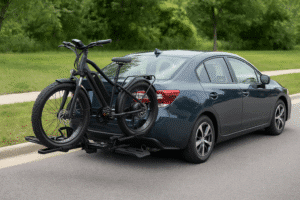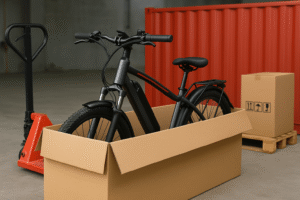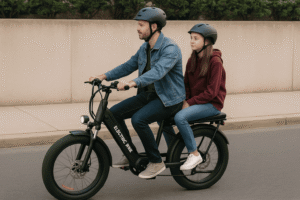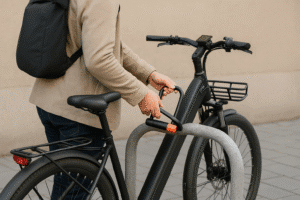Electric bikes are sometimes allowed on sidewalks in the U.S., but the rules depend on where you are. Many cities let Class 1 and 2 e-bikes use the sidewalk, especially in low-traffic areas, while others ban all e-bikes to protect pedestrians. Class 3 e-bikes are usually not allowed due to their higher speed.
I’ve had to figure it out myself, and what I found was a mix of laws, safety concerns, and some surprising gray areas. Here’s what you need to know, straightforward and without the fluff.
TL;DR
You might be able to ride an electric bike on the sidewalk, but it depends on local laws. Many cities ban e-bikes on sidewalks, especially faster Class 3 models, to keep pedestrians safe. Some areas allow Class 1 or 2 bikes in low-traffic zones or when no bike lanes are available. Even if it’s legal, riding on sidewalks can lead to accidents, fines, or liability.
Safer options include bike lanes, quiet streets, or shared-use paths. Always check your local laws before riding and be respectful if you must use the sidewalk.
General Rules About Riding on Sidewalks
Electric bikes might feel like regular bikes, but legally, they don’t always get treated the same. In most places, riding any kind of bike—especially one with a motor—on the sidewalk is either restricted or flat-out banned.
The main reason? Sidewalks are meant for pedestrians. Adding a 20 mph e-bike into the mix can create dangerous situations. Cities and towns often have rules in place to keep walkers safe, and many of those rules say, “Keep the bikes off the sidewalk.”
But not every place has the same rules. Some cities are more relaxed, especially in areas where sidewalks are wide or foot traffic is light. Still, it’s on you to check your local laws—don’t assume just because you see others doing it, that it’s legal.
Can You Ride an Electric Bike on the Sidewalk?
You can’t ride an electric bike on the sidewalk in many places, especially in large cities like New York or San Francisco. Local laws vary. Some areas allow sidewalk riding if no bike lane is available and the road is unsafe. Always check local regulations before riding on sidewalks.
That said, it’s not always black and white. Some states treat e-bikes the same as traditional bikes, which means sidewalk riding might be allowed in quieter neighborhoods or areas with wider paths. But cities with heavy foot traffic usually say no, mainly to protect pedestrians.
Even if it’s technically legal where you live, that doesn’t always mean it’s a good idea. E-bikes move fast, and sidewalks are full of people, kids, pets—you name it. Riding there can feel awkward at best and dangerous at worst.
Why Sidewalk Riding is Controversial
Riding an e-bike on the sidewalk sounds convenient, but it raises a lot of eyebrows. That’s because it mixes fast-moving bikes with slow-moving people. Here’s why it’s such a hot topic:
- Pedestrian safety – A 50 lb e-bike going 20 mph isn’t something you want near someone walking their dog or pushing a stroller.
- Accidents and injuries – Crashes between bikes and pedestrians happen more than you’d think, and they can get messy.
- Legal confusion – With rules changing from town to town, riders often don’t know what’s legal or not.
- Speed difference – People walk at around 3 mph. E-bikes can go five times faster. That’s a huge gap in reaction time.
Understanding E-Bike Classes and Sidewalk Rules
To make things more complicated, sidewalk laws often depend on what type of e-bike you’re riding. In the U.S., electric bikes are split into three classes.
- Class 1 e-bikes only work with pedal assist and stop helping at 20 mph. These are usually seen as the “safest” and are sometimes allowed on sidewalks.
- Class 2 e-bikes have a throttle and can move without pedaling, but also top out at 20 mph. Some cities treat them the same as Class 1, while others restrict them more.
- Class 3 e-bikes assist up to 28 mph. These are typically banned from sidewalks entirely and meant for roads or bike lanes.
When I bought my first Class 2 bike, I assumed I could take it on the sidewalk if I kept it slow. A quick chat with my local bike shop proved me wrong—it’s not about how you ride, it’s about what the law says about your bike’s class.
Understanding your e-bike’s classification can save you a lot of trouble—not just with the law, but with the people walking right next to you.
What Do Local and State Laws Say?
This is where things get messy. E-bike laws can change from one block to the next—literally. Some states have rules that apply across the board, while others leave it up to individual cities or counties. That means what’s allowed in one town might get you a ticket in the next.
Here’s how it often plays out:
- New York City doesn’t allow any e-bikes on sidewalks, no matter the class.
- California restricts sidewalk riding in many cities, especially for Class 3 bikes.
- Colorado and Idaho allow Class 1 and 2 e-bikes on sidewalks—unless local ordinances say otherwise.
- Michigan lets you ride on sidewalks unless a local rule prohibits it.
- Florida allows sidewalk riding, but you still have to yield to pedestrians and follow posted signs.
Bottom line? Don’t rely on general advice. Look up the rules in your city before you ride.
When Sidewalk Riding May Be Allowed
There are a few exceptions where riding an e-bike on the sidewalk might be okay—but even then, it’s not a free-for-all.
- If there are no bike lanes and the road feels unsafe.
- In low-traffic neighborhoods with wide sidewalks.
- When you’re riding at walking speed and yielding to pedestrians.
- If you’re a younger rider—some areas make exceptions for children.
- In places where signs say it’s okay or designated shared-use paths exist.
Legal and Financial Consequences

If you get caught riding where you shouldn’t, don’t expect a friendly warning every time. In some cities, you could be looking at a decent fine, even if you were just trying to get around traffic. I’ve seen cases where riders were fined for sidewalk use even when they were going slow and careful.
There’s also the liability side. If you hit someone while riding on a sidewalk, you might be legally responsible for their injuries.
That means medical bills, lawsuits, or worse. Pedestrian collisions can get expensive quickly, and e-bike riders often take the blame, even if the accident wasn’t entirely their fault.
On top of that, you risk damaging your e-bike or injuring yourself if you’re forced to swerve around a pedestrian, curb, or bench. It’s a lot of risk for a shortcut.
Tips for Safe Riding If You Must Use the Sidewalk
If you’re somewhere that allows e-bikes on sidewalks, or you’re riding in a rare situation where it’s safer, there are ways to do it responsibly.
- Go slow. Think walking pace—not racing mode.
- Use a bell or say “On your left!” before passing someone.
- Stay alert. Pedestrians can stop or turn suddenly.
- Yield the right of way. Always let people walk first.
- Watch driveways and crosswalks. Cars won’t expect you there.
- Ride predictably. No weaving between people or sudden moves.
Better Alternatives to Sidewalk Riding
Honestly, sidewalks aren’t made for e-bikes. There are better—and safer—ways to get around. I stick to bike lanes whenever I can, and if those aren’t available, I look for quiet residential streets with low speed limits.
Some parks and national forests also have shared-use trails that allow both bikes and walkers, and those tend to be wide enough to avoid awkward interactions. Planning your route ahead of time makes a big difference. There are apps that show bike-friendly routes, and some cities even post maps online.
If you’re not sure where to ride, local bike shops are usually happy to help. They often know which areas are best avoided and where you can ride without trouble.
Final Words
So, can you ride an electric bike on the sidewalk? In many places, no. And even where it is allowed, it comes with rules, risks, and responsibilities.
If you want to stay out of trouble (and avoid hurting anyone), check your local laws, ride respectfully, and consider better alternatives like bike lanes or quiet streets.
E-bikes are an awesome way to get around—but they work best when you ride them in the right place, at the right pace.
FAQs
Is it legal to ride a bike on the sidewalk in the US?
It depends on the state and city. Some places allow it, but many have rules. In 21 states, you must yield to pedestrians, and in 18 states, you need to give a warning, like ringing a bell, before passing. A few states also have speed limits for bikes on sidewalks.
Can kids ride e-bikes on sidewalks?
It depends on the local laws. Some areas allow younger riders to use sidewalks for safety, but others still require all e-bike riders—regardless of age—to follow the same rules as adults.
What happens if I get caught riding illegally?
You might get a warning, but in many places, it could mean a fine. If there’s an accident, you could also be held responsible for any injuries or damage.
How do I know my e-bike’s class?
Check the manufacturer’s label or user manual. Most e-bikes in the U.S. are labeled as Class 1, 2, or 3 based on how fast they go and whether they use pedal-assist or throttle.
Is sidewalk riding ever safer than road riding?
Sometimes, yes—like when the road has no shoulder or traffic is heavy. But it can also be more dangerous in crowded areas. If you do ride on the sidewalk, slow down and always watch out for pedestrians.
Al Amin Morshed is the founder of BoltBikers and a seasoned e-bike reviewer with years of hands-on experience testing electric bikes. As a long-time e-bike enthusiast, he combines real-world riding insights with in-depth research to create honest, helpful content for riders of all levels. Through BoltBikers, Morshed aims to make e-biking more accessible, practical, and enjoyable – whether you’re a new rider or a daily commuter looking for the best gear.








